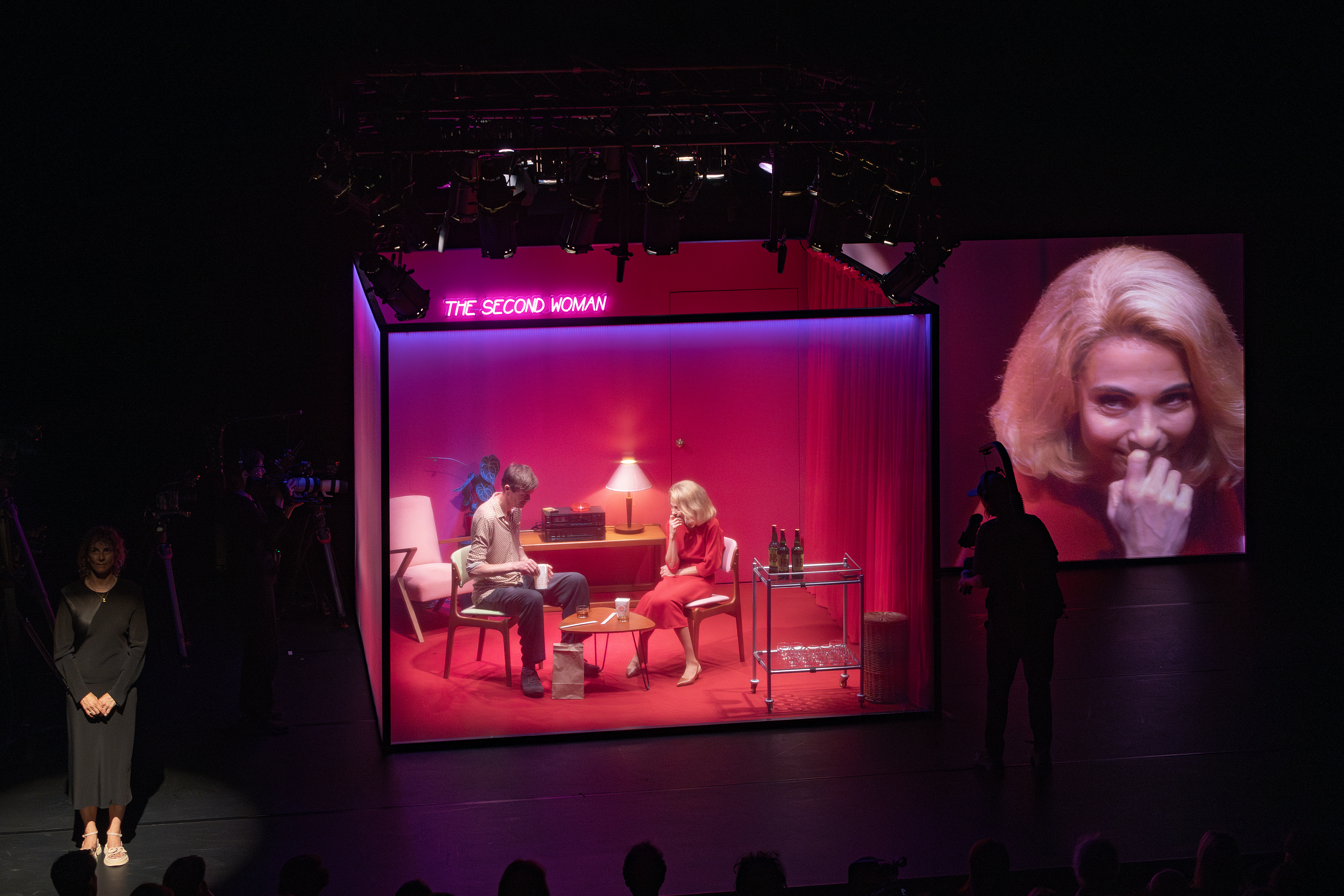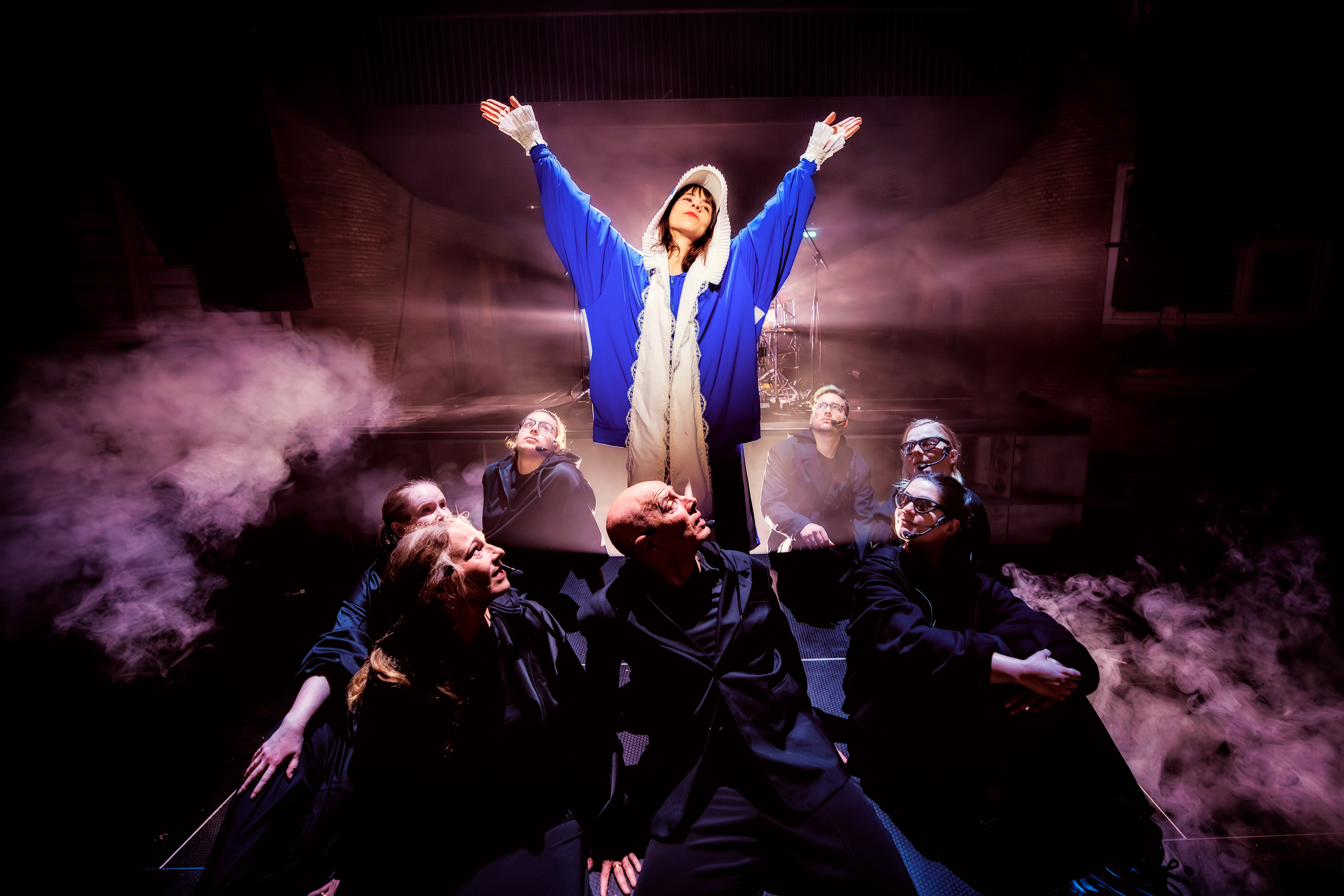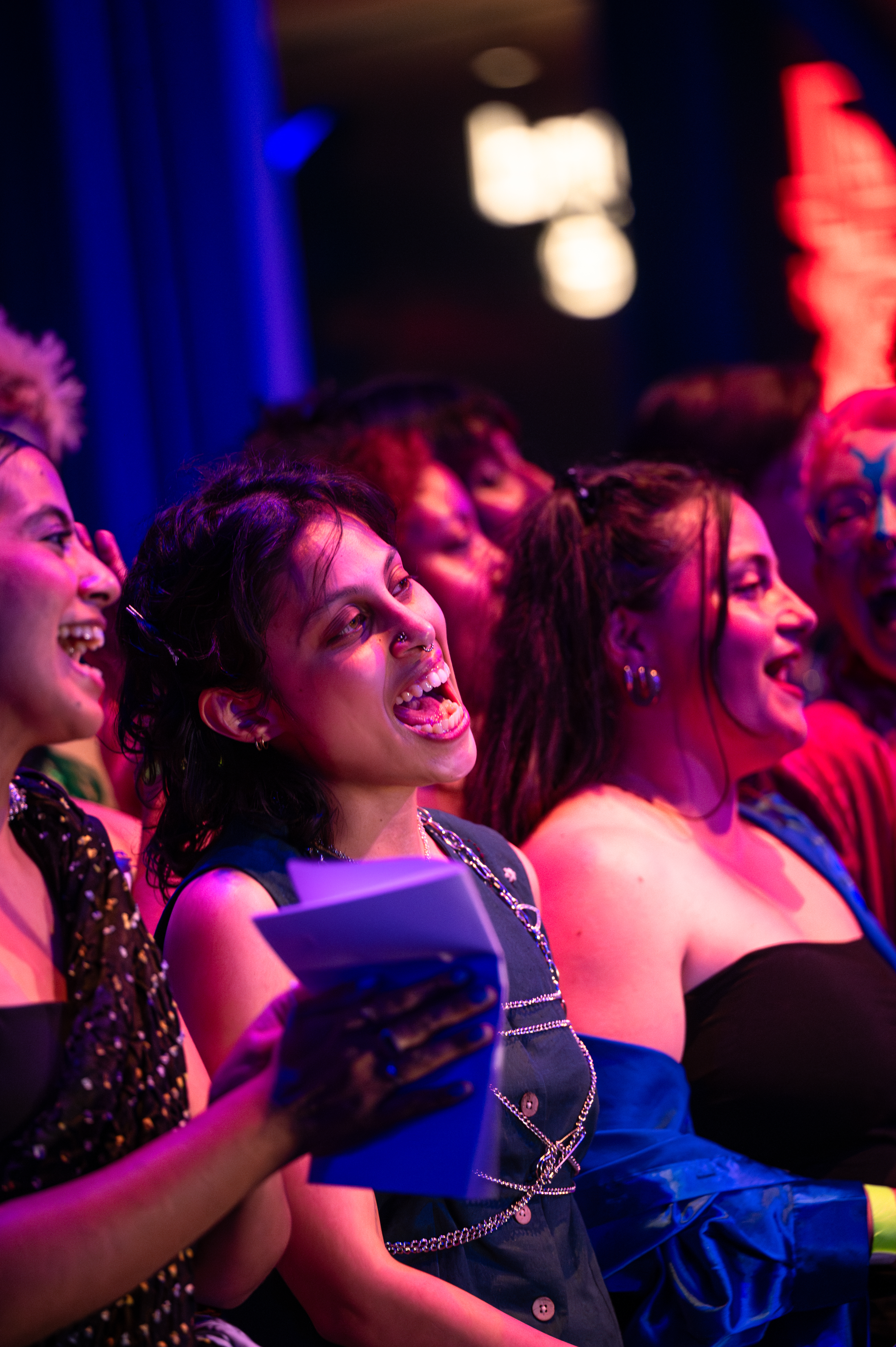Brazil as a mirror of the world
Jatahy’s input gave the 77th edition of the Holland Festival a strong Brazilian flavour. As the associate artist said herself during her artist-to-artist talk with theatre makers and compatriots Janaina Leite and Carolina Bianchi: ‘You can take me out of Brazil, but never take Brazil out of me; I’ll carry this with me wherever I go.’ With its melting pot population and unique ecology, Brazil is also the world in a nutshell, with all its problems and possibilities. No other country has everything converge in such an urgent way: climate change, environmental crime, migration, social inequality, racism and historical slavery.

These last themes were central to the piece Macacos, which had a particularly great impact in Brazil, but was never before presented abroad, and which was the first piece Jatahy suggested. In this virtuoso theatrical monologue, Clayton Nascimento drew the historical line of deep-rooted racism that runs from Europe’s colonisation of Brazil to its independence and the present. The heartbreaking story of nine-year-old Eduardo who was killed by police bullets was embedded in a Brazilian history lesson, which for once wasn’t told from the perspective of the conquerors but that of the oppressed, who are structurally dismissed as monkeys (macacos).
Apart from Nascimento, who is only well-known in Brazil, the Holland Festival also presented the internationally acclaimed Arthur Verocai. Since his 1972 debut album was picked up by Frank Zappa and Miles Davis, and later was widely sampled by hip hop artists like MF Doom and Ludacris, he has become an absolute cult hero. The currently 79 years old Verocai presented his catchy blend of samba, jazz, funk and bossa nova during his performance with the Metropole Orchestra. The concert connected generations. Not just onstage, where Verocai’s son played as well and Brazilian singer-songwriter Rogê made his debut in the Netherlands as Verocai’s guest, but also in the venues, where teens holding records under their arms hoped to get an autograph of the master. Even the poster on the front of the Concertgebouw building was stolen as a souvenir afterwards.
Grupo Cena 11 showed a very different side of Brazil. The dance performance Eu não sou só eu em mim combined anarchic choreography, punk aesthetics and techno music.
Breaking the fourth wall
The divide between stage and audience was surprisingly often actively eliminated, which meant empathising with the other was no longer a non-binding option. Halfway through Macacos, for instance, Clayton Nascimento had the venue’s lighting above the seating area turned on for a right-or-wrong quiz on Brazil’s colonial history. During The Faggots and Their Friends Between Revolutions, the audience was directly involved with poking fun (with a serious undertone) at the gains of the radical right during the recent parliamentary elections in the Netherlands. The fourth wall was broken with Stabat Mater, Sisyphe, PEARLS and HARDKOOR as well. This even happened literally in Hamlet - In the Folds of Time, when the projection screen in front of the stage fell down, and Hamlet directly addressed the venue with the words ‘être ou pas être’. At the end of the piece, the backdrop turned into a mirror for a fraction of a second, making the fusion of stage and audience complete.
 Another way of raising festival visitors’ sense of involvement is an extremely long submersion in the parallel world of the piece, which sharpens the focus and taps into a deeper layer of experience. Georgina Verbaan ended her relationship countless times for a full 24 hours in The Second Woman. Like a modern-day Sisyphus, Victor Pilon moved sand from one end of the Transformatorhuis to the other six hours a day for twelve days long. The same number of days saw a performer living open and exposed in the Stedelijk Museum’s exhibition space in the Marina Abramović performance The House with the Ocean View. And in Mutability, visitors wandered through a musical forest where algorithms determined the order, musical context and performance style of thirteen compositions for six hours long (or part of this).
Another way of raising festival visitors’ sense of involvement is an extremely long submersion in the parallel world of the piece, which sharpens the focus and taps into a deeper layer of experience. Georgina Verbaan ended her relationship countless times for a full 24 hours in The Second Woman. Like a modern-day Sisyphus, Victor Pilon moved sand from one end of the Transformatorhuis to the other six hours a day for twelve days long. The same number of days saw a performer living open and exposed in the Stedelijk Museum’s exhibition space in the Marina Abramović performance The House with the Ocean View. And in Mutability, visitors wandered through a musical forest where algorithms determined the order, musical context and performance style of thirteen compositions for six hours long (or part of this).
Spaceship lifting off
In order to appeal to as many visitors as possible in different ways and establish connection, the Holland Festival presented a diverse mix of performances, exhibitions and context programmes. In the festival’s tradition of large-scale projects like Aus Licht (2019) and Euphoria (2023), this year saw 11.000 Saiten performed in the Gashouder. Georg Friedrich Haas’ microtonal music is no standard fare, but the 1080 seats were fully filled two times in a row with listeners who heard all kinds of things in it, from ‘the motorway with all the windows rolled down’ to ‘a spaceship lifting off’. It was a big contrast with the four people max that Flavio Orzari received in his performative installation Spellotics in order to find magical solutions to socio-political issues together.
With Fidelio, the Dutch National Opera brought Beethoven’s only opera to the stage, directed by Andriy Zholdak and with the Royal Concertgebouw Orchestra in the pit. Wu Tsang presented her interpretation of Bizet’s Carmen with a theatre company, Schauspielhaus Zürich, and had the main character played by a woman, a non-binary person and a male cross-dresser. The whole production was set up, performed and taken down again in just two days - a feat that ordinarily would take three times as long.

Dutch productions
In Het Sieraad, a new location for the Holland Festival, Naomi Velissariou took the audience through her burnout. For HARDKOOR she collaborated with the Netherlands Chamber Choir and Theater Utrecht, while the other Dutch productions were also all about new connections for telling new stories. For The Bird of a Thousand Voices, director Boris Acket and film maker Ruben van Leer worked together with an international group of musicians who performed a modern version of an Armenian folktale onstage. And members of Zaandam/Amsterdam-based band The Ex joined forces with the Brazilian Metá Metá for an improvised soundtrack to Mario Peixoto’s experimental 1931 film Limite.
A great number of people also visited Dries Verhoeven’s living installation Everything must go, which will be presented in different parts of the Netherlands later in the year as well. HARDKOOR will also be touring the country, and The Bird of a Thousand Voices will go on to other places as well, including Antwerp and Paris. In such cases the festival always tries to strike a balance between exclusivity and sustainability, and deems the interests of the maker(s), collaboration with other venues and maximising performance moments of generally greater importance than the need to show unique and exclusive work. Wunderbaum collaborated for the first time with Landestheater Niederösterreich and the Tangente St. Pölten - Festival für Gegenwartskultur. In their performance ALFA, Alfa Romeo enthusiasts from Italy, Germany and the Netherlands came together to share their passion for the car brand, but also their position in a changing society.
Immersed
The programme was deliberately organised in such a way as to make it easy to combine visits to multiple performances in a single day, especially in the weekends. If you wanted, you could start by visiting an art installation, followed by watching a matinee performance, joining a Meet the Artist event or catching up in the Holland Festival Living Room, watching an evening performance and ending with a club night. This made for a real festival atmosphere where visitors constantly ran into each other, a sense of community among the likeminded. Information and thoughts were shared, maybe even resulting in new friendships.
 The club night and various parties on Fridays and Saturdays were an important part of the weekend programme. The Holland Festival has organised such events more often in the past, but recently included structural attention to nighttime culture in its policy plan. This year kicked off with a club night in Lofi, with Brazilian music and sound art. In line with The Faggots and Their Friends Between Revolutions, Queer Choir Amsterdam and House of Lostbois took care of the party evening An unapologetic night out. The third weekend saw the theatre space of Frascati 2 turned into a dance floor: FRASC at NIGHT. Under cover of night, conventional gender roles and hierarchies were dismantled, allowing all to find an alternative home.
The club night and various parties on Fridays and Saturdays were an important part of the weekend programme. The Holland Festival has organised such events more often in the past, but recently included structural attention to nighttime culture in its policy plan. This year kicked off with a club night in Lofi, with Brazilian music and sound art. In line with The Faggots and Their Friends Between Revolutions, Queer Choir Amsterdam and House of Lostbois took care of the party evening An unapologetic night out. The third weekend saw the theatre space of Frascati 2 turned into a dance floor: FRASC at NIGHT. Under cover of night, conventional gender roles and hierarchies were dismantled, allowing all to find an alternative home.
Artistic crossing for professionals
This year’s festival saw a Professionals Weekend organised for the first time. A group of 45 directors and programmers of theatres, art centres and festivals from the Netherlands and abroad met up, made new connections and discussed burning issues in the performing arts.
For the second year, the Holland Festival organised a unique exchange programme for young festival makers from outside Europe in order to share experiences and talk about the different institutional, societal and cultural contexts we work in. This year two programmers from Egypt and South Korea tagged along in the Festival Exchange. The director and programmer of the Holland Festival, in turn, will visit these countries in order to learn from their respective practices.
As part of the annual Immerse programme, an international group of seven makers at the start of an international career visited performances together. There was also plenty of interaction among festival artists, allowing for new networks to shape. As the associate artist was in Amsterdam for the entire month, and so wasn’t tied to her usual hit-and-run travel schedule, Jatahy could watch performances from others and talk with colleagues. And she certainly wasn’t the only one. Composers Yannis Kyriakides and Georg Friedrich Haas, for instance, had a talk behind the scenes of Mutability. Other artists visited performances and/or rehearsals of colleagues as well. By making such informal encounters possible, the Holland Festival acts as a home for makers.
